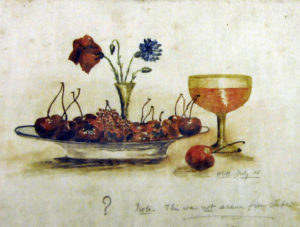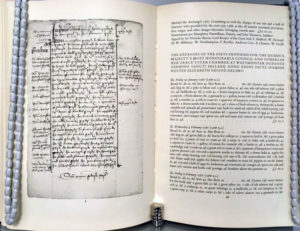The IHR Library recently celebrated the opening of its latest exhibition, All the Right Ingredients: Food History Resources in the IHR Library.
Food as a source of nourishment is a necessity of life, but it also has deeper significance. Its importance ensures that it forms the backdrop to everyday lives throughout history. The multi-layered and diverse areas of food history allow researchers to examine the social, cultural, political, and economic perspectives of the past. Through food history, historians can gain a window onto societies at the macro and micro levels, enabling them to research a range of issues such as gender roles, identity, emotions, familial relationships, memory, class, and race.
Within the discipline of history today, the study of food and the closely related research on foodways and culinary history are ever-expanding and rapidly developing areas of historical enquiry. This exhibition therefore explores the wealth of resources in the IHR Library’s collections to demonstrate the ways in which food history can offer fresh perspectives on historical narratives.
 The first display case in the exhibition examines culinary history through a selection of cookery books and recipes. Examples include recipes for ‘apple omelet’, ‘Spanish sauce’, and ‘beef or mutton broth for very weak people who take but little nourishment.’ In this way, the recipes on display illuminate historical interactions between peoples and cultures and provide a window onto the social and economic past of the societies in which they were served.
The first display case in the exhibition examines culinary history through a selection of cookery books and recipes. Examples include recipes for ‘apple omelet’, ‘Spanish sauce’, and ‘beef or mutton broth for very weak people who take but little nourishment.’ In this way, the recipes on display illuminate historical interactions between peoples and cultures and provide a window onto the social and economic past of the societies in which they were served.
 The second display focuses upon food history in personal testimonies. Multiple examples in the Library’s collections show the importance of food to individuals during times of conflict and celebration, through scarcity and abundance, and during everyday life. Demonstrative of this are the drawings Lance-Corporal Henry Buckle sketched during the First World War. These beautiful depictions of food reveal the dark humour of the trenches and the central role food played in the lives of soldiers. The sketch shown here (right) bears the caption, ‘Note this was *not* drawn from life.’
The second display focuses upon food history in personal testimonies. Multiple examples in the Library’s collections show the importance of food to individuals during times of conflict and celebration, through scarcity and abundance, and during everyday life. Demonstrative of this are the drawings Lance-Corporal Henry Buckle sketched during the First World War. These beautiful depictions of food reveal the dark humour of the trenches and the central role food played in the lives of soldiers. The sketch shown here (right) bears the caption, ‘Note this was *not* drawn from life.’
In the third cabinet, the history of food as recorded within official records and documents is highlighted. Included within the display is a facsimile of the Sugar Act passed by the British Parliament in 1764 and the detailed accounts of dinners provided for the Lords of the Privy Council in Westminster during the reigns of Queen Elizabeth I and King James I of England. Such records demonstrate the importance of food in history as a commodity, whether for use in ceremonial practices or in establishing control over trade.
 The final display is devoted to the history of food in the IHR. Through a series of archival documents, photographs and personal accounts, the display demonstrates that food has held a central role in the history of the Institute, both in formal gatherings such as parties and dinners, and through informal meetings over tea and coffee in the Common Room. A selection of the documents on display include a menu from a sherry party held in 1938 in conjunction with Fortnum & Mason, a seating plan from the Institute’s ‘Dining Club’ dinner of 1958, and photographs of the Common Room prior to refurbishment.
The final display is devoted to the history of food in the IHR. Through a series of archival documents, photographs and personal accounts, the display demonstrates that food has held a central role in the history of the Institute, both in formal gatherings such as parties and dinners, and through informal meetings over tea and coffee in the Common Room. A selection of the documents on display include a menu from a sherry party held in 1938 in conjunction with Fortnum & Mason, a seating plan from the Institute’s ‘Dining Club’ dinner of 1958, and photographs of the Common Room prior to refurbishment.
Throughout, the exhibition aims to highlight the range of materials available in the Library’s collections and demonstrate the possibilities food history can afford historians. The exhibition is on display in the third floor reading room throughout the summer and is open to all.
The exhibition was developed in consultation with Dr Kelly Spring, Convener of the Food History Seminar at the IHR. Further information on the seminar can be found here or on Twitter @IHR_FoodHist.

